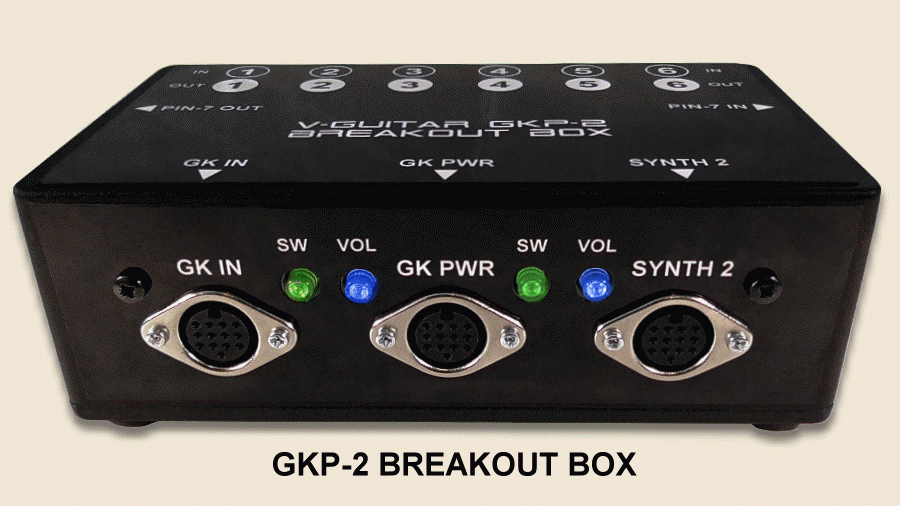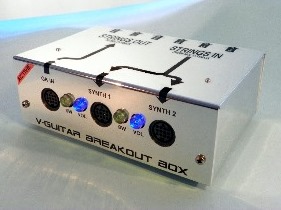|
GKP-2 BREAKOUT BOX Passive breakout box with 3/5 of a Roland GKP-4 distribution box capability. A GK Hex pickup can control two separate v-synths, and record/play separate strings simultaneously. SPECIFICATIONS |
|
|
FRONT PANEL |
THREE 13-PIN CHASSIS SOCKETS: GK IN (Left Connector), GK OUT (GK Power) Centre Connector, GK OUT (SYNTH 2) Right Connector. SWITCHES: Four LED switches: Two patch ON/OFF selector switches. Two volume selector switches ON/OFF. GKP-4 distribution type operation. |
|
BACK PANEL |
12 T/S MONO 6.35mm JACK SOCKETS: Six T/S mono 6.35mm separate string outputs (E, A, D, G, B, E). Six T/S mono 6.35mm jacks separate string line-level inputs for v-guitar re-amping and effect inserts. Two ‘normal guitar’ Pin-7 I/O 6.35mm T/S jack sockets. ‘Pin-7 IN’ is a buffered ‘switch-jack’ normal-guitar input. |
|
AUDIO |
SIGNAL-TO-NOISE RATIO OR DYNAMIC RANGE: 90dB with a separate string output (Roland GK-3 typically). Separate string Total-harmonic-distortion = 0.00550% or better. Hex pickup/preamp dependent. String cross-talk is hex pickup dependent . Separate string separation is generally around 35-40dB, but can go as low as 7-10dB depending on playing technique and relative notes played. |
|
DIMENSIONS |
Length 153mm. Depth 84mm. Height 52mm. |
|
WEIGHT |
520 grams. |
|
SEPARATE STRING RECORDING AND SOFTWARE EDITING |
DC-offset, normalize, noise-gate, re-tune, reverse, volume, cut, split, copy, paste, move, delete etc. |
|
V-SYNTH HANDS-FREE PATCH CHANGING |
GUITAR AND PICKUP SELECT: Stratocaster - Les Paul -Telecaster-Acoustic etc. RE-AMPING: Change amp, adjust amp controls, change speaker cabinet, adjust microphone/placement etc. EFFECTS: Change effects, adjust controls, change effects sequence etc. |
|
GKP-2 Breakout Box price : £180.00GBP. Plus tracked shipping. |
|

|
|
|
|
|
|
|
|
|
|
|
RECOMMENDED LINKS |

GKP-2 BREAKOUT BOX REVIEW BY PAUL WHITE OF SOS MAGAZINE
https://www.soundonsound.com/reviews/tonesearch

ToneSearch
Hex-pickup Breakout Box
Signal Processors
By Paul White
Published May 2013
The ToneSearch V-Guitar Breakout Box is an ingenious little passive device that serves a number of useful functions when connected to the output of a guitar that's fitted with Roland's GK-series hexaphonic pickups.
Firstly, it can function as a splitter, enabling one GK-equipped guitar to control two separate GK-compatible devices. For example, it enables you to use one guitar to control both a VG-series processor and a GR-series guitar synth module at the same time. Secondly, it makes all six individual analogue string outputs available on standard audio jack plugs. Used with a multi-channel audio interface, this means you could feed each string's signal to a separate track in your DAW, record, edit and process the resulting recordings however you want, and then replay those tracks back, through this box, to your GK-compatible synth or processor. That opens up countless creative possibilities, and given that pitch-tracking based guitar synths such as Roland's GR-series are notorious for responding to every accidental string touch and squeak, this could prove particularly useful for cleaning up the individual string tracks, and perhaps applying tuning and level correction too.
Conceptually, the box is very simple, with one GK input connector and two 13-pin outs, one of which must be connected to the GK-compatible device that will power the pickup electronics. Six TRS jacks carry the signals for strings, with one string pair per socket (three output jacks and three input jacks). You'll also need an extra Roland 13-pin cable, which is available as a cost option. There are switches for each 13-pin output to determine whether the GK pickup button messages are to be passed on or not and the same for the GK volume control. If the Volume switch is turned off, the signals come out at full volume.
Connection is easy, though if only one GK unit is connected it has to be plugged into to the centre connector labelled Power, as this is the unit that passes on power to the GK pickup electronics. The GK guitar plugs into the input, while 'Y' leads (which can also be supplied by the company) must be used to feed the discrete string outputs to six of the line inputs on your audio interface.
If you plan to use the recorded signals to drive a VG-series device, you'll also need to hook up three more 'Y' cables from six outputs on your interface and feed these back into the string input jacks on the V-Guitar Breakout Box.
If you're going to feed the recorded string signals back into the GR or VG synth/processor, you need to make sure you match up the playback levels so they're as close as possible to what came out of the GK pickup in the first place if you want to recreate the original performance dynamics, but other than that there's nothing complicated to worry about.
When recording the individual strings for further processing, the first thing I noticed was how much louder the low strings were than the high ones when all the input gains were set equally, so I had to adjust the height of my GK pickup to even things out. (This was actually a very educational process, as it showed me just how much the GK pickup height affects the output signal from each string: even with the best balance I could attain, the middle two strings were a touch down in sensitivity, which suggests either that the pickup radius didn't quite match that of my Strat fingerboard or that the bridge saddle heights for the middle two strings were set a fraction high. A slight adjustment to the interface gains for those two strings, though, and I was good to go.)
Having record-armed six channels in my DAW, I set about capturing a few strummed parts and single-note lines, and then tried processing the strings in different ways. My first impression was that the output from the pickup sounded rather more like that from a normal guitar pickup than I'd anticipated, and using amp model plug-ins copied across all six tracks it was possible to create a very clean and separate-sounding polyphonic overdrive. Pitch-shifting the bottom three strings up by an octave also produced a reasonably convincing Nashville tuning. Another fun trick I tried was to put rotary effects on all the strings but have them running at slightly different speeds — a pleasingly textural effect. In fact, the results really are limited only by your imagination, and with the creative use of plug-ins you can conjure up a wealth of synth-like effects using only effects and processors.
When I first tried this unit, I thought it unfortunate that there was no power option available for this box. Since that time, an active version has become available, which is driven by two 9V PP3 batteries, which means you require minimal gain from your interface's preamps. I think that there's potential for futher development in this area: some users might find it useful also to have a version available that could supply power from its battery or an external PSU to the GK pickup, so you can explore the processing possibilities even if you don't have a GR or VG hardware unit to play the signals back through. Discussing this with designer Bill Baxendale, he said that while this isn't currently a standard option, several people have asked him about the possibility. He also said that he's more than happy to explore customisation options on a per-user basis. Whichever way you look at it, if you already own a GK/GR/VG system, the V-Guitar Breakout Box has the potential to add a whole new creative dimension to your guitar setup. Paul White.
£180 plus delivery.
separate-strings.co.uk








